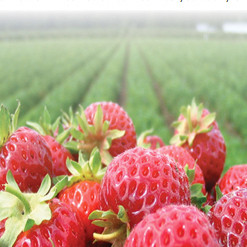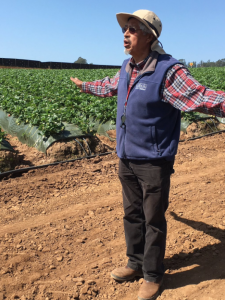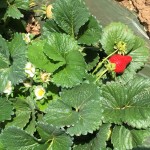 April 19, 2016 – Last week we reported that strawberries—the number one crop locally—had come out on top of the Environmental Working Group’s 2016 “Dirty Dozen” list of the most pesticide-laden produce.
April 19, 2016 – Last week we reported that strawberries—the number one crop locally—had come out on top of the Environmental Working Group’s 2016 “Dirty Dozen” list of the most pesticide-laden produce.
Coincidentally, we already had a press tour scheduled for the following day with the California Strawberry Commission and they wasted no time slamming the EWG report.
“They don’t set their list according to any research-based science,” said communications director Carolyn O’Donnell. “A child would have to eat more than 1,500 servings of (conventionally grown) strawberries in one day to be affected by any residues.”
The Watsonville-based strawberry commission, which represents 400 conventional and organic growers statewide, organized the tour last Wednesday for about 15 reporters and food bloggers.
We visited the beautiful 41-acre farm of conventional grower Miguel Ramos just off San Andreas Rd. Apart from being a delightful host, Ramos was chosen to drive home the point that most California strawberries are grown on small family farms and that two-thirds of those farms are owned by Latinos.

Like Mr. Ramos—who was born in Guanajuato, Mexico—one in four Latino strawberry farmers started out as immigrant field workers. He began cultivating strawberries in 1983 on just one acre of leased land and grew the business little by little.
“We call strawberries the crop of opportunity,” said O’Donnell. “The path to the American dream literally winds its way through California’s strawberry fields.”
Asked if he ever considered going organic, Ramos demurred saying there are so many risks in growing strawberries that he prefers to stick with what he knows.
“There is no secret to growing strawberries,” he said. “You just have to be consistent.”
The EWG report said federal officials found pesticide residues on 98% of washed and ready-to-eat strawberries tested, some with up to 17 different pesticides. Their goal is to get people to buy organically grown fruits and vegetables.
 It went on to say that 300 pounds of pesticides are used per acre in growing strawberries—a figure Ramos said was probably low.
It went on to say that 300 pounds of pesticides are used per acre in growing strawberries—a figure Ramos said was probably low.
Nonetheless, the strawberry commission in a written statement said: “Science clearly shows that organic and conventional strawberries are safe to eat and pesticide residues do not pose a safety concern.”
Strawberries are such a nutrient-dense super food, that promoters say the health benefits far outweigh any risks. And those concerned about pesticides can always buy organic.
Said Ramos: “Strawberries are the shape of our hearts and the color of our blood, if you can’t feel the passion you better move on to something else.”
Read the CA Strawberry Commission full statement here.
Read EWG full strawberry report here.
About the author
Deborah Luhrman is publisher and editor of Edible Monterey Bay. A lifelong journalist, she has reported from around the globe, but now prefers covering our flourishing local food scene and growing her own vegetables in the Santa Cruz Mountains.
- Deborah Luhrmanhttps://www.ediblemontereybay.com/author/dluhrman/
- Deborah Luhrmanhttps://www.ediblemontereybay.com/author/dluhrman/
- Deborah Luhrmanhttps://www.ediblemontereybay.com/author/dluhrman/
- Deborah Luhrmanhttps://www.ediblemontereybay.com/author/dluhrman/


